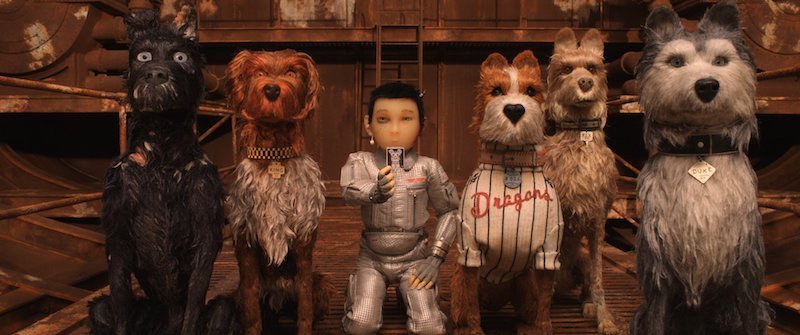
Considering how fastidious he is, how tidily he arranges his frames, how fussy he is about every aesthetic detail in his films, you’d think Wes Anderson would be a cat guy. After all, cats are rather notoriously finicky themselves. Well, he’s not. Anderson’s new, stop-motion animated film is many things—a dystopian sci-fi, an homage to Japanese film and culture (with some unfortunate missteps we’ll get to in a bit), a rollicking adventure, a droll comedy, but it’s mostly a love letter to dogs. In fact, say the title out loud and you’ll see just how explicit that love letter is.
We’re in a fictionalized version of Japan, 20 years in the future. There’s been an outbreak of the canine diseases snout fever and dog flu. The cat-loving Mayor Kobayashi of Megasaki city has exiled all the dogs to Trash Island, where they are to live off of maggot-infested scraps and fend for themselves, until they die off, presumably. Most residents of Megasaki accept the propaganda that their dogs are a health hazard but little Atari (Koyu Rankin), the orphaned ward of the mayor, is determined to find his beloved dog Spots (Liev Schreiber). He commandeers a plane that he doesn’t fully know how to fly and heads to the island. Naturally, he crash lands. (Did I mention that he’s 12?) The gang of scruffy and flea-infested dogs that rule the portion of the island where Atari has landed—they’re voiced by the likes of Edward Norton, Bob Balaban, Bill Murray, and Jeff Goldblum—immediately suss out Atari’s mission and agree to help him. However, alpha dog Chief (Bryan Cranston) wants no part of it. He was a street dog himself—a self-proclaimed “biter” who answered to no master—and he has no time for helping the boy.
“Why should I?” he growls to his lady friend, the former show dog Nutmeg (Scarlett Johansson).
“Because he’s a 12 year old boy,” she responds. “Dogs love those.”
One of the many remarkable things about Isle of Dogs is how invested we become in the relationship between Atari and Chief—a boy who needs a dog and a dog who, whether he wants to admit it or not, needs a boy. It’s important to remember that, for all his meticulousness and precision, Anderson is a sentimentalist himself. And despite its many dark touches—an autocratic government, visual references to mushroom clouds (every explosion and dog fight is depicted by a roiling blob of smoke-like cotton), a rather grim sequence involving a dog who starved to death in his cage— this might be his most sentimental film yet.
But the film is not without its issues. There’s been a lot of talk on Twitter and elsewhere about Anderson’s cultural tourism, the unfortunate “Orientalism” that pervades the film. In some ways, it makes sense that Anderson would be so drawn to Japanese culture: Japanese culture is filled with meticulous ritual and compartmentalization of its own—hotel pods! Bento boxes! Bonsai trees! And Anderson is clearly a devotee of Akira Kurosawa, which hardly makes him unique among contemporary auteurs, but the homage here is heartfelt. But you can have affection and admiration for a culture without fully understanding that culture, or being the appropriate ambassador of that culture. And many of Anderson’s choices don’t help his cause.
For one, there’s the matter of language. The dogs are all voiced by American actors, making them the easiest to understand and relate to. This makes sense in a film about dogs, of course, but it has the effect of “othering” the Japanese characters, who all speak in their native language, without subtitles (although they are occasionally interpreted by a translator, voiced by Frances McDormand). What’s more, with the exception of Atari and a few thinly sketched out members of the pro-dog/anti-Kobayashi “Science Party” (including one voiced by Yoko Ono!) most of the Japanese characters are bad—or at least passive. Worst of all, he introduces a dreaded white savior, an adolescent school girl with a riot of yellow curls voiced by Greta Gerwig, who leads a resistance movement to help save Atari. Why, oh why, did Anderson feel compelled to add this little white girl to the mix? It’s almost indefensible. (I don’t expect my favorite auteurs to be up to speed on the latest cultural conversations on Twitter, but we’ve been talking about the scourge of white saviors for decades.)
Look, Isle of Dogs has lots to recommend: It’s gorgeous—filled with so many bits of visual whimsy and imaginative detail that it would take several viewings to fully catch them all. And it’s idiosyncratic and witty and dark. In short, it’s a Wes Anderson film about dogs (so, basically, two of my favorite things). But even America’s foremost cinematic symmetrist needs to get rapped on the snout sometimes. In this case, he belongs in the dog house.
